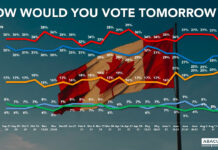BY BRUCE ANDERSON & DAVID COLETTO
Abacus Data Inc.
Conservatives shed 5 points, NDP up 4
OUR latest horserace “who would you vote for tomorrow” question shows an extremely tight race, with the Conservatives at 31% and the NDP and the Liberals each at 28%.
In the provinces with the most seats and the largest sample sizes, the Liberals have a slight lead over the Conservatives in Ontario and the NDP has a sizeable lead over the Liberals in Quebec. We see a close three-way race in BC.
A closer look at some of the demographic patterns suggests that some movement from the Conservatives towards the NDP is happening among voters 60 and older, traditionally a critical bastion of Conservative support. NDP support has also grown in the last month among those with higher levels of education, homeowners, and union members.
More Canadians are in the mood for change
Our latest results show a 7-point jump in the number of people who think it would be good to have a change in government in Ottawa, and a corresponding drop in the number of people who thing “it’s definitely best to keep the Conservatives in office”. In this wave, 76% say they would prefer to see a change, although not all of these people feel strongly about the need for change.
Huge proportion of votes up for grabs
Only 25% of those polled say, “I know how I will vote and that won’t change”. Among this group, 37% intend to vote Conservative. One way to interpret this is that the resolute CPC vote is 9% today, 3 points higher than that of the NDP or Liberals, but not exactly large.
Another 35% say they have “a fairly good idea, but that could change”. Among this group, all three major parties have an equal share of voting intentions.
Just about a quarter (23%) say “I have only a slight leaning at this time” and 17% say they “don’t really know which party they will vote for at this time.
Among those who voted Conservative in 2011, many are not fully committed to supporting the party again. Just one in three of those who voted Conservative say they know how they will vote and that won’t change (92% are voting Conservative). The other two thirds of their 2011 coalition say they are not necessarily with the Conservatives at this point.
NDP potential expands. No party enjoys a large, loyal base
In the last month, we see a 5-point increase in the percentage of people who say they would consider voting NDP, giving the party now the largest potential voter pool at 56%, followed by the Liberals at 51% and the Conservatives at 45%. Just about a third would consider voting Green.
The percentage of those who would consider voting NDP is up the most in Quebec (+10) but is also up in Atlantic Canada (+12) with slight increases in BC (+4), Alberta (+4), and Ontario (+2).
Cross-tabulating these results, reveals that the base pool (would only consider this party) for the Conservatives is 15%, for the NDP is 16% and for the Liberals is 10%.
Who cares about this election?
One in four Canadians “care deeply about the outcome of this election” and LPC and NDP voters are a little more likely to feel this way than Conservative voters. This measure of motivation is something we will watch going forward as it often has a bearing on turnout. Another 53% say they are interested in the election, which includes more Conservatives than Liberals or New Democrats.
How do Canadians see this turning out?
Prognostication in these circumstances in getting a lot tougher, and when asked how they think the election will turn out, Canadians are reflecting this uncertainty. Today 26% think the Liberals will win, 24% say the Conservatives (down 12 points in a month) and 15% say the NDP (up 6 points in the month and 8 points over the last quarter). Growth in the belief that the NDP could win is up in many parts of the country, not only in Quebec.
The Upshot?
These results are the clearest evidence to date of a phenomenon that has been seen in several recent provincial elections – polls well in advance of an election can suggest stability in public opinion when in fact there is a remarkable softness to voting intentions.
The true core vote for any of the three main parties, is actually less than 20% today, partly a function of long term disengagement of many people from the political process. We can count on more shifting around of support than ever before, and less predictability.
Today’s numbers indicate that the desire for change in Ottawa is rising. There is a larger potential for the NDP brand to consolidate the “change vote” than we have seen in the past. However, the Liberal brand is highly competitive, especially in the critical battleground of Ontario, and is seen as a more likely victor in October.
The results are sobering news for Conservative election planners. While our data had shown an uptick in support based on the recent budget, this effect has dissipated. With 20 weeks to Election Day the incumbents are struggling to build enthusiasm around their economic record or plans, and as our next release will reveal, the terror / security issue is losing momentum for the CPC as well.
All three parties have a chance to win the next election. But none can expect to win it without out-campaigning the others. And that means drawing voters beyond core loyalists.












